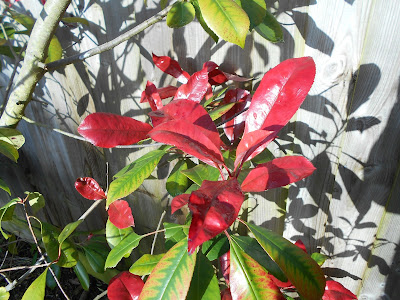 |
Photinia davidiana make a neat and rather unusual hedge.
Stefen Hill, Daventry. 30 October, 2017
|
Of course that is nonsense, they did exist but masqueraded under a different name and in older books they are referred to as Stranvaesia species. Thus Photinia davidiana, The best-known species, was Stranvaesia davidiana. If the word 'stranvaesia' sounds odd, then blame the Latin language; the genus was named after William Fox-Strangeways, 4th Earl of Ilchester. Strictly speaking there is no 'w' in Latin and so Strangeways became Stranvaesia. Fortunately not all taxonomists have been quite so pedantic, for we have Lewisia, Wolffia, Weigela and so on.
Photinias, as members of the Rose Family, Rosaceae, are closely related to Cotoneaster and Pyracantha (but fortunately without the thorns of the latter) and share similar flowers and berries, Unfortunately, to encourage the bright red new growth, the shrub is often pruned quite hard so the flowers and fruit are lost. The removal of the berries may partly explain why the species is only occasionally naturalised.
As for the specific name, it commemorates the French missionary and explorer Armand David, remembered not only in this species, but also in the lovely tree Davidia involucrata and Pere David's Deer, Elaphurus davidianus, a herd of which may be seen at Woburn Abbey. [Note 1]
Now, in the depths of winter the cheerful bright red of the younger leaves is welcome but it does seem sad that secateurs and hand saws are so often taken to this potentially lovely tree.
Notes
1. The history of Pere David's Deer is a curious one. Armand David sent a carcass of the animal back to Europe where it was recognised as a new species. A few live specimens were then sent (illegally) back to Britain where a herd was established at Woburn. Shortly afterwards the species was declared extinct in the wild but fortunately those at Woburn were flourishing and subsequently (1985) some were returned to China and have been established in a wildlife reserve.
Photinias, as members of the Rose Family, Rosaceae, are closely related to Cotoneaster and Pyracantha (but fortunately without the thorns of the latter) and share similar flowers and berries, Unfortunately, to encourage the bright red new growth, the shrub is often pruned quite hard so the flowers and fruit are lost. The removal of the berries may partly explain why the species is only occasionally naturalised.
As for the specific name, it commemorates the French missionary and explorer Armand David, remembered not only in this species, but also in the lovely tree Davidia involucrata and Pere David's Deer, Elaphurus davidianus, a herd of which may be seen at Woburn Abbey. [Note 1]
Now, in the depths of winter the cheerful bright red of the younger leaves is welcome but it does seem sad that secateurs and hand saws are so often taken to this potentially lovely tree.
 |
Photinia still providing colour. Stefen Hill, Daventry.
10 January, 2017
|
Notes
1. The history of Pere David's Deer is a curious one. Armand David sent a carcass of the animal back to Europe where it was recognised as a new species. A few live specimens were then sent (illegally) back to Britain where a herd was established at Woburn. Shortly afterwards the species was declared extinct in the wild but fortunately those at Woburn were flourishing and subsequently (1985) some were returned to China and have been established in a wildlife reserve.
No comments:
Post a Comment